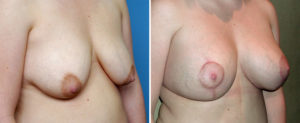The sagging breast poses one of the most difficult problems in cosmetic plastic surgery. While many patients assume that the simple placement of a breast implant will create the effect of a breast lift while making it bigger, this perception is usually wrong. This may work for the smallest amount of breast sagging. But for more substantative degrees of sagging, an implant will make the breast mound bigger but may actually worsen the breast sagging problem by merely pushing it downward.
Breast sagging comes in varying degrees and the well known system of breast ptosis classification provides a simplistic numbering system for them. While the numbers (type I to IV) make it seem simple, treating it is not as easy. As the nipple position descends from close to the inframammary fold and lower, the concept of a combined breast implant and lift is needed. This common combination approach to ‘breast rejuvenation’ is fraught with many aesthetic difficulties and a very high rate of revision.
The difficulty of the combined breast implant lift procedure is a surprise to most patients. Understandably they have no idea that it is so difficult because both techniques work against the other one. Breast lifting is about removing skin, tightening the mound and lifting the nipple. Conversely, breast implants are about expanding the size of the mound, filling out loose skin and pushing the nipple outward. How to balance these two opposing forces is both an issue of experience and artistic sense, not to mention the influence of how the patient tissues heals in the face of two easy to judge structures sitting side by side. As a result, the complication rates and the need for revisions to optimize the aesthetic result is 50% or higher in most plastic surgeon’s hands…if the patient seeks an optimal result.
Because of the high revision rate, plastic surgeons have taken two approaches to this combined breast reshaping…either do both a lift and an implant together and separate them into two stages. Plastic surgeons have differing opinions on either approach and there is no universally accepted standard approach that is right for every patient. To some degree it depends on the amount of breast sagging and asymmetry, for many patients it comes down to an issue of economics and recovery.

The biggest problem in determining whether a one-stage approach has a high chance of success is that there is not objective measure of how the skin will respond. Breast ptosis classifications are too simplistic and do not take into account how the elasticity, or lack thereof, of the breast skin envelope. Not all breast ptosis II, III, IVs respond the same to implant expansion and skin tightening.
While many plastic surgeons use a very specific set of measurements to determine how the lift is done in a combined procedure, I prefer the ‘cut as you go’ technique. This marks out a minimal amount of early skin removal and tailor tacks the lift and skin excess on top of an implant sizer. This prevents ever removing too much skin which can be pose healing problems. This method definitely airs on the conservative side, potentially leaving a little too much skin which can cause breast tissue afterward off the front edge of the implant.
If the procedure is staged, it is almost always best to do the lift first. This not only looks better in the short term but makes it easier to select a better sized implant at the second stage. Good healing time should be allowed before placing the implant which is usually no less than three months. The only exception to this sequence is in the patient where there is a debate about the real need for a lift or the patient has great scar concerns and wants to let the result dictate the need for the breast lift.
Dr. Barry Eppley
Indianapolis, Indiana


